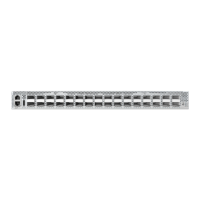C
HAPTER
46
| Multicast Routing Commands
PIM Multicast Routing
– 1092 –
Graft Retry Interval : 3 sec
Max Graft Retries : 3
State Refresh Ori Int : 60 sec
Console#
ip pim This command enables PIM-DM on the specified interface. Use the no form
to disable PIM-DM on this interface.
SYNTAX
[no] ip pim {dense-mode | sparse-mode}
dense-mode - Enables PIM Dense Mode.
sparse-mode - Enables PIM Sparse Mode.
DEFAULT SETTING
Disabled
COMMAND MODE
Interface Configuration (VLAN)
COMMAND USAGE
◆ To fully enable PIM, you need to enable multicast routing globally for
the router with the ip multicast-routing command, enable PIM globally
for the router with the router pim command, and also enable PIM-DM
or PIM-SM for each interface that will participate in multicast routing
with this command.
◆ If you enable PIM on an interface, you should also enable IGMP on that
interface. PIM mode selection determines how the switch populates the
multicast routing table, and how it forwards packets received from
directly connected LAN interfaces.Dense mode interfaces are always
added to the multicast routing table. Sparse mode interfaces are added
only when periodic join messages are received from downstream
routers, or a group member is directly connected to the interface.
◆ Dense-mode interfaces are subject to multicast flooding by default, and
are only removed from the multicast routing table when the router
determines that there are no group members or downstream routers,
or when a prune message is received from a downstream router.
◆ Sparse-mode interfaces forward multicast traffic only if a join message
is received from a downstream router or if group members are directly
connected to the interface. When routers want to receive a multicast
flow, they periodically send join messages to the Rendezvous Point
(RP), and are subsequently added to the shared path for the specified
flow back up to the RP. If routers want to join the source path up
through the Shortest Path Source Tree (SPT), they periodically send
join messages toward the source. They also send prune messages
toward the RP to prune the shared path if they have already connected

